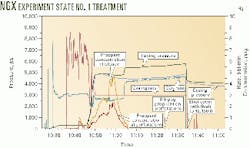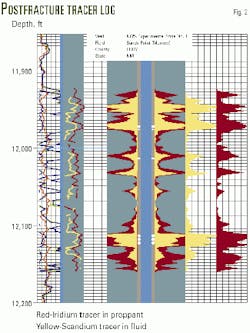Downhole mixing of carbon dioxide (CO2) with fracturing fluid allowed for better control of a hydraulic frac treatment in a Morrow gas zone, according to RealTimeZone Inc., Roswell, NM, developer of the process.
The US Department of Energy (DOE) partly funded the test under its program to develop "real-time monitoring of reservoir stimulation procedures via electronic wireline and telemetry."
The program includes additional testing to be conducted in 2001 on real-time monitoring of frac jobs.
Treatment description
NGX Experimental State No. 1, a 12,300-ft Morrow gas well in the Sand Point field, Eddy County, NM, was the site of the test. The frac treatment (Fig. 1) consisted of a methanol gel with 7,000-lb bauxite proppant pumped down the tubing and 40-tons liquid CO2 pumped down the annulus.
George Scott, intellectual property manager for RealtimeZone, explained that the post-fracture tracer log from the well (Fig. 2) shows that the treatment placed the proppant in the Morrow deep gas reservoir zone. He said this well, which had been scheduled for plugging by a prior operator, is now producing about 250 Mcfd.
RealtimeZone developed this real-time downhole-blending system with assistance from the DOE National Energy Technology Laboratory (NETL). Scott said the technology provides for true real-time modification of both fluid rheology and proppant concentrations on the fly.
He said that typically the Morrow frac jobs cost about $80,000 or more, require high wellhead pressures, approaching 10,000 psi, and frequently are limited in size because about 25% of the jobs screen out.
He estimated that comparable fracs with downhole mixing would cost only half as much, about $40,000, because the lower friction and treating pressures require less hydraulic horsepower for pumping the fluid.
He added that with this system, a reservoir stimulation procedure may be modified in response to a number of different criteria, such as abruptly rising treating pressures that typically signal premature screenout.
Thus, in response to an indicated premature screenout, the stimulation job could be rapidly altered in real-time to reduce proppant concentrations, or to increase gel viscosity or other aspects of fluid rheology to prevent a screenout. This system enhances the operator's control of fracture geometry and proppant placement in the reservoir.
Another benefit to this type of program is the use of CO2, which in combination with other components, including methanol, cleans-up the fracturing fluids faster as the CO2 expands into gas during flowback to the wellbore via the propped fracture.
Real-time monitoring
One remaining project in the DOE program relates to real-time monitoring of downhole-blended stimulation treatments. Most of this work is included under Phase 3, which starts in 2001.
In RealtimeZone's work to date, a gamma-ray logging tool, the Halliburton Energy Services' Spectrascan, monitored stimulation in real-time (Fig. 3). The real-time log, plotted on a time-track, was acquired with a wireline tool that was held stationary in the tubing while the treatment was pumped down the casing annulus. The log was acquired during the fracturing of a Willow Lake Delaware oil reservoir, Eddy County, NM.
The Spectrascan logging tool was placed in the wellbore prior to initiation of the frac job.
Scott explains that they observed, in real-time, both fluid (yellow Scandium tracer) and then proppant (red Iridium tracer) moving downward towards water-bearing strata and as a result the treatment was modified to avoid stimulating the wet zones.
RealtimeZone conducted this work with assistance from Halliburton Energy Services (HES). Scott and Harry Smith, HES Director of R&D, coauthored a patent related to this real-time project.
Scott said the upcoming Phases 2-3 work will further field test these concepts and include several real-time monitored jobs.





